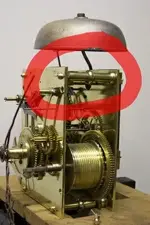You are using an out of date browser. It may not display this or other websites correctly.
You should upgrade or use an alternative browser.
You should upgrade or use an alternative browser.
Heavy little rod thing...
- Thread starter thedukeofdelaware
- Start date
- Joined
- Mar 16, 2011
- Messages
- 13,961
- Reaction score
- 16,564
- Golden Thread
- 1
- Location
- San Diego
- 🥇 Banner finds
- 1
- 🏆 Honorable Mentions:
- 3
- Detector(s) used
- Equinox 800/900, Fisher Impulse AQ, E-Trac, 2 Excal 1000's, White's TM808, VibraProbe, 15" NEL Attack, Mi6, Steath 920ix and 720i scoops, TRX, etc....
- Primary Interest:
- All Treasure Hunting
What metal? Hollow? Threaded?
Upvote
0
thedukeofdelaware
Sr. Member
- #3
Thread Owner
I'm still pretty new at this, how can I tell what metal it is? Not hollow and not threaded.
Upvote
0
8Keeper
Jr. Member
- Joined
- Nov 5, 2017
- Messages
- 41
- Reaction score
- 38
- Golden Thread
- 0
- Location
- Daytona, FL
- Primary Interest:
- Shipwrecks
Looks hollow at the fat end. If so I would guess some type of brush handle. Old shaving brush?
Upvote
0
TheCannonballGuy
Gold Member
- Joined
- Feb 24, 2006
- Messages
- 6,606
- Reaction score
- 13,446
- Golden Thread
- 0
- Location
- Occupied CSA (Richmond VA)
- Detector(s) used
- White's 6000, Nautilus DMC-1, Minelab
- Primary Interest:
- Relic Hunting
Thedukeofdelaware asked:
> ""I'm still pretty new at this, how can I tell what metal it is?
Duke, with more experience you'll be able to tell the ID of the most common varieties of metals by the color of their patina (oxidation/corrosion) and its "texture" (smooth, grainy, chalky, or brittle), and the metal's comparative heaviness, and its comparative strength.
Patina color and texture:
Copper and brass (which is an alloy of copper with "about" 25% zinc) tend form a greenish or brownish fairly smooth-textured patina... although in highly acidic soil it can be chalky or grainy. (Your "heavy little rod thing" appears to be made of brass.) Very old PURE lead tends to form a white-ish patina. Lead-alloys (such as solder, and 20th Century bullet-lead) tend to be a smooth-textured medium to dark grey. "Pot-metal" (a cheap alloy used for making very inexpensive jewelry, souvenir belt-buckles and toy guns, etc) tends to be medium grey to dark grey with a chalky or crumbly surface.
I must mention that there are occasional exceptions to metal patina ID-characteristics information above. I'm just telling you what we "most often" see.
Weight:
Lead is heavier than zinc and pot-metal, which is heavier than aluminum.
Strength:
Lead and aluminum are easily bend-able.
Most folks dislike making a scrape on something they've dug, but sometimes a tiny scrape is needed to determine the original color of the metal... such as pink/orange for copper, and yellow for brass, and pale-yellow for bronze.
Try doing some metal-ID learning tests on junk metal you dig.
> ""I'm still pretty new at this, how can I tell what metal it is?
Duke, with more experience you'll be able to tell the ID of the most common varieties of metals by the color of their patina (oxidation/corrosion) and its "texture" (smooth, grainy, chalky, or brittle), and the metal's comparative heaviness, and its comparative strength.
Patina color and texture:
Copper and brass (which is an alloy of copper with "about" 25% zinc) tend form a greenish or brownish fairly smooth-textured patina... although in highly acidic soil it can be chalky or grainy. (Your "heavy little rod thing" appears to be made of brass.) Very old PURE lead tends to form a white-ish patina. Lead-alloys (such as solder, and 20th Century bullet-lead) tend to be a smooth-textured medium to dark grey. "Pot-metal" (a cheap alloy used for making very inexpensive jewelry, souvenir belt-buckles and toy guns, etc) tends to be medium grey to dark grey with a chalky or crumbly surface.
I must mention that there are occasional exceptions to metal patina ID-characteristics information above. I'm just telling you what we "most often" see.
Weight:
Lead is heavier than zinc and pot-metal, which is heavier than aluminum.
Strength:
Lead and aluminum are easily bend-able.
Most folks dislike making a scrape on something they've dug, but sometimes a tiny scrape is needed to determine the original color of the metal... such as pink/orange for copper, and yellow for brass, and pale-yellow for bronze.
Try doing some metal-ID learning tests on junk metal you dig.
Last edited:
Upvote
0
Thedukeofdelaware asked:
> ""I'm still pretty new at this, how can I tell what metal it is?
Duke, with more experience you'll be able to tell the ID of the most common varieties of metals by the color of their patina (oxidation/corrosion) and its "texture" (smooth, grainy, chalky, or brittle), and the metal's comparative heaviness, and its comparative strength.
Patina color and texture:
Copper and brass (which is an alloy of copper with "about" 25% zinc) tend form a greenish or brownish fairly smooth-textured patina... although in highly acidic soil it can be chalky or grainy. (Your "heavy little rod thing" appears to be made of brass.) Very old PURE lead tends to form a white-ish patina. Lead-alloys (such as solder, and 20th Century bullet-lead) tend to be a smooth-textured medium to dark grey. "Pot-metal" (a cheap alloy used for making very inexpensive jewelry, souvenir belt-buckles and toy guns, etc) tends to be medium grey to dark grey with a chalky or crumbly surface.
I must mention that there are occasional exceptions to metal patina ID-characteristics information above. I'm just telling you what we "most often" see.
Weight:
Lead is heavier than zinc and pot-metal, which is heavier than aluminum.
Strength:
Lead and aluminum are easily bend-able.
Most folks dislike making a scrape on something they've dug, but sometimes a tiny scrape is needed to determine the original color of the metal... such as pink/orange for copper, and yellow for brass, and pale-yellow for bronze.
Try doing some metal-ID learning tests on junk metal you dig.
Pretty good description of the metals.
70/30 yellow brass (70%copper30%zinc) takes in a wide variety of brass finds from what we dig up today. Bullet casings, zipper pulls, clock parts, most stamped brass are all the same.
Casted brass can be a mixture of copper as the main base 75-80%+ then a mixture of tin, lead, aluminum, etc. and when one can breakdown the subgroups it can run into 100+ different brasses and copper alloys. (Just an idea on how different applications/alloys are used) This will apply for your main metals Aluminum, brass, copper, lead, zinc, stainless steel, nickel. Which then the subgroups will tally up to be in the 1000's
Basically the redder it is the higher the copper content in brass. Take an old plumbing tap from the early 1900's and it will be red brass, a new one will be yellow, as stated above the colour will ID the brass. Red brass will break and will have a crumble effect when looked at closely, where as yellow will have a clean cut look.
Upvote
0
Similar threads
- Replies
- 2
- Views
- 357
Users who are viewing this thread
Total: 1 (members: 0, guests: 1)








